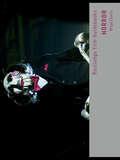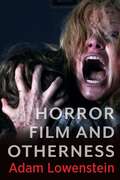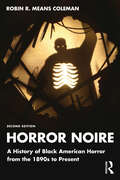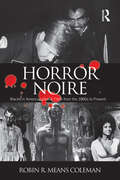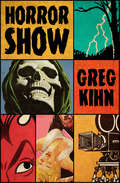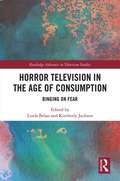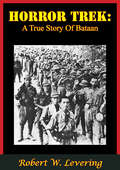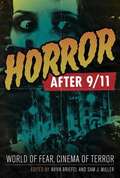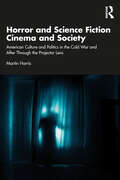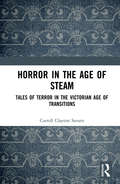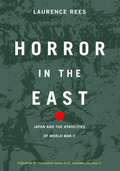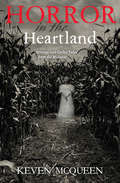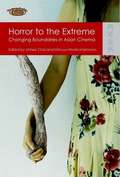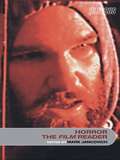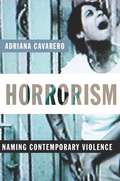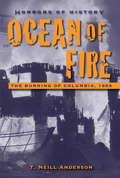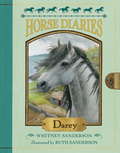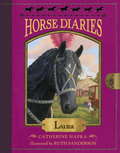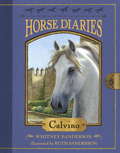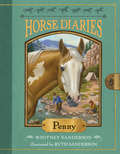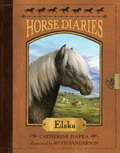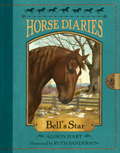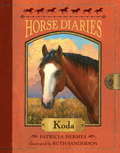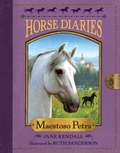- Table View
- List View
Horror (Routledge Film Guidebooks)
by Brigid CherryHorror cinema is a hugely successful, but at the same time culturally illicit genre that spans the history of cinema. It continues to flourish with recent cycles of supernatural horror and torture porn that span the full range of horror styles and aesthetics. It is enjoyed by audiences everywhere, but also seen as a malign influence by others. In this Routledge Film Guidebook, audience researcher and film scholar Brigid Cherry provides a comprehensive overview of the horror film and explores how the genre works. Examining the way horror films create images of gore and the uncanny through film technology and effects, Cherry provides an account of the way cinematic and stylistic devices create responses of terror and disgust in the viewer. Horror examines the way these films construct psychological and cognitive responses and how they speak to audiences on an intimate personal level, addressing their innermost fears and desires. Cherry further explores the role of horror cinema in society and culture, looking at how it represents various identity groups and engages with social anxieties, and examining the way horror sees, and is seen by, society.
Horror Film and Otherness (Film and Culture Series)
by Adam LowensteinWhat do horror films reveal about social difference in the everyday world? Criticism of the genre often relies on a dichotomy between monstrosity and normality, in which unearthly creatures and deranged killers are metaphors for society’s fear of the “others” that threaten the “normal.” The monstrous other might represent women, Jews, or Blacks, as well as Indigenous, queer, poor, elderly, or disabled people. The horror film’s depiction of such minorities can be sympathetic to their exclusion or complicit in their oppression, but ultimately, these images are understood to stand in for the others that the majority dreads and marginalizes.Adam Lowenstein offers a new account of horror and why it matters for understanding social otherness. He argues that horror films reveal how the category of the other is not fixed. Instead, the genre captures ongoing metamorphoses across “normal” self and “monstrous” other. This “transformative otherness” confronts viewers with the other’s experience—and challenges us to recognize that we are all vulnerable to becoming or being seen as the other. Instead of settling into comforting certainties regarding monstrosity and normality, horror exposes the ongoing struggle to acknowledge self and other as fundamentally intertwined.Horror Film and Otherness features new interpretations of landmark films by directors including Tobe Hooper, George A. Romero, John Carpenter, David Cronenberg, Stephanie Rothman, Jennifer Kent, Marina de Van, and Jordan Peele. Through close analysis of their engagement with different forms of otherness, this book provides new perspectives on horror’s significance for culture, politics, and art.
Horror Noire: A History of Black American Horror from the 1890s to Present
by Robin R. Means ColemanFrom King Kong to Candyman, the boundary-pushing genre of horror film has always been a site for provocative explorations of race in American popular culture. This book offers a comprehensive chronological survey of Black horror from the 1890s to present day. In this second edition, Robin R. Means Coleman expands upon the history of notable characterizations of Blackness in horror cinema, with new chapters spanning the 1960s, 2000s, and 2010s to the present, and examines key levels of Black participation on screen and behind the camera. The book addresses a full range of Black horror films, including mainstream Hollywood fare, art-house films, Blaxploitation films, and U.S. hip-hop culture-inspired Nollywood films. This new edition also explores the resurgence of the Black horror genre in the last decade, examining the success of Jordan Peele’s films Get Out (2017) and Us (2019), smaller independent films such as The House Invictus (2018), and Nia DaCosta’s sequel to Candyman (2021). Means Coleman argues that horror offers a unique representational space for Black people to challenge negative or racist portrayals, and to portray greater diversity within the concept of Blackness itself. This book is essential reading for anyone seeking to understand how fears and anxieties about race and race relations are made manifest, and often challenged, on the silver screen.
Horror Noire: Blacks in American Horror Films from the 1890s to Present
by Robin R Means ColemanFrom King Kong to Candyman, the boundary-pushing genre of the horror film has always been a site for provocative explorations of race in American popular culture. In Horror Noire: Blacks in American Horror Films from 1890's to Present, Robin R. Means Coleman traces the history of notable characterizations of blackness in horror cinema, and examines key levels of black participation on screen and behind the camera. She argues that horror offers a representational space for black people to challenge the more negative, or racist, images seen in other media outlets, and to portray greater diversity within the concept of blackness itself. Horror Noire presents a unique social history of blacks in America through changing images in horror films. Throughout the text, the reader is encouraged to unpack the genre’s racialized imagery, as well as the narratives that make up popular culture’s commentary on race. Offering a comprehensive chronological survey of the genre, this book addresses a full range of black horror films, including mainstream Hollywood fare, as well as art-house films, Blaxploitation films, direct-to-DVD films, and the emerging U.S./hip-hop culture-inspired Nigerian "Nollywood" Black horror films. Horror Noire is, thus, essential reading for anyone seeking to understand how fears and anxieties about race and race relations are made manifest, and often challenged, on the silver screen.
Horror Show (Special Warfare Ser.)
by Greg KihnA Bram Stoker Award finalist for Best First Novel: This endlessly inventive thriller pays homage to 1950s Hollywood horror films--with a demonic twist Schlock horror director Landis Woodley lives in a decaying mansion in the Hollywood Hills. When he abandoned the movie business--after being reduced to filming skin flicks and peep shows--he also left a laundry list of enemies, including the IRS. But avid fan Clint Stockbern is determined to write a piece on the alcoholic recluse for Monster magazine. Woodley agrees to the interview--for $600 in cash. As the tape recorder starts rolling, Stockbern travels back in time with Woodley. He hears recollections of Attack of the Haunted Saucer, the worst movie of all time, and Blood Ghouls of Malibu. But he really wants to know about Woodley's masterpiece, Cadaver. Shot on location in the Los Angeles County morgue, the film was rumored to have used real corpses and everyone associated with the production has been fatally haunted since its 1957 release. But the truth is far more terrifying than Stockbern imagined. Is a dead Satanist, possessed by the devil, reaching out beyond the grave? Or is the reporter the final victim in a diabolical scheme dreamed up by mortals? Horror Show is a wild and wacky romp that sends up mid-century Hollywood horror movies and schlockmeisters Roger Corman, William Castle, and Ed Wood.
Horror Television in the Age of Consumption: Binging on Fear (Routledge Advances in Television Studies)
by Kimberly Jackson Linda BelauCharacterized as it is by its interest in and engagement with the supernatural, psycho-social formations, the gothic, and issues of identity and subjectivity, horror has long functioned as an allegorical device for interrogations into the seamier side of cultural foundations. This collection, therefore, explores both the cultural landscape of this recent phenomenon and the reasons for these television series’ wide appeal, focusing on televisual aesthetics, technological novelties, the role of adaptation and seriality, questions of gender, identity and subjectivity, and the ways in which the shows’ themes comment on the culture that consumes them. Featuring new work by many of the field’s leading scholars, this collection offers innovative readings and rigorous theoretical analyses of some of our most significant contemporary texts in the genre of Horror Television.
Horror Trek: A True Story Of Bataan
by Robert W. LeveringThis record of the personal experiences and first-hand knowledge of the early days of the war in the Philippines; the tragic defense of Bataan; the horrors of the Death March; the sadistically planned and executed inhuman sufferings forced upon the valiant survivors of the operations of war, doomed to a life or death existence as so-called prisoners of war, is vividly portrayed in these pages called "Horror Trek."The author, Robert W. Levering, through love of country and inherent natural instincts of character and principle, elected to follow his comrades in arms to the field of battle rather than accept the comparative safety offered to civilian internees in "Santo Tomas."
Horror after 9/11
by Aviva Briefel Sam J. MillerHorror films have exploded in popularity since the tragic events of September 11, 2001, many of them breaking box-office records and generating broad public discourse. These films have attracted A-list talent and earned award nods, while at the same time becoming darker, more disturbing, and increasingly apocalyptic. Why has horror suddenly become more popular, and what does this say about us? What do specific horror films and trends convey about American society in the wake of events so horrific that many pundits initially predicted the death of the genre? How could American audiences, after tasting real horror, want to consume images of violence on screen? Horror after 9/11 represents the first major exploration of the horror genre through the lens of 9/11 and the subsequent transformation of American and global society. Films discussed include the Twilight saga; the Saw series; Hostel; Cloverfield; 28 Days Later; remakes of The Texas Chainsaw Massacre, Dawn of the Dead, and The Hills Have Eyes; and many more. The contributors analyze recent trends in the horror genre, including the rise of ‘torture porn,’ the big-budget remakes of classic horror films, the reinvention of traditional monsters such as vampires and zombies, and a new awareness of visual technologies as sites of horror in themselves. The essays examine the allegorical role that the horror film has held in the last ten years, and the ways that it has been translating and reinterpreting the discourses and images of terror into its own cinematic language.
Horror and Science Fiction Cinema and Society: American Culture and Politics in the Cold War and After Through the Projector Lens
by Martin HarrisExamining how horror and science fiction films from the 1950s to the present invent and explore fictional “us-versus-them” scenarios, this book analyzes the different ways such films employ allegory and/or satire to interrogate the causes and consequences of increasing polarization in American politics and society.Starting with the killer ants film with an anti-communist subtext Them! (1954) and concluding with Jordan Peele’s social horror film with revenge-seeking homicidal doppelgängers Us (2019), Martin Harris highlights social and political contexts, contemporary reviews and responses, and retrospective evaluations to show how American horror and science fiction films reflect and respond to contemporary conflicts marking various periods in U.S. history from post-WWII to the present, including those concerning race, gender, class, faith, political ideology, national identity, and other elements of American society.Horror and Science Fiction Cinema and Society draws upon cinematic sociology to provide a resourceful approach to American horror and science fiction films that integrates discussion of plot construction and character development with analyses of the thematic uses of conflict, guiding readers’ understanding of how filmmakers create otherworldly confrontations to deliver real-world social and political commentary.
Horror in Paradise
by James Cornell[from the back cover] "For almost a month Mt. Pelée, the long-dormant volcano towering over the city of St Pierre on the island of Martinique, had been sending out warning signals: clouds of thick yellow-brown smoke, loud rumbles, avalanches of mud and rocks that crushed trees and rooftops in the surrounding countryside. At night the sky glowed with a brilliant ominous red. The experts poohpoohed these warnings. The Governor of the island listened to the experts. No evacuation of the city was ordered. Then, on the morning of May 8, 1902, at 7:50 A.M. Mt. Pelée awoke with a vengeance. An explosion heard for hundreds of miles poured flaming gases and jets of superheated steam down onto the sleeping city, turning it into a living hell. By 7:53 A.M. all but three of its 30,000 inhabitants were dead. Of these three survivors, two died within hours. The third was a convicted murderer awaiting execution in a dungeon deep beneath the city jail. The only survivor of St Pierre was a man condemned to die! 30 dramas of death and destruction. And they're all true!"
Horror in the Age of Steam: Tales of Terror in the Victorian Age of Transitions
by Carroll Clayton SavantChange is terrifying, and rapid change, within a small amount of time, is destabilizing to any culture. England, under the tutelage of Queen Victoria, witnessed precipitous change the likes of which it had not encountered in generations. Wholesale swaths of the economy and the social structure underwent complete recalibration, through the hands of economic progress, industrial innovation, scientific discovery, and social cohesiveness. Faced with such change, Britons had to redefine the concept of work, belief, and even what it meant to be English. Victorians relied on many methods to attempt to release the steam from the anxieties incurred through change, and one of those methods was the horror story of everyday existence during an age of transition. This book is a study of how authors Elizabeth Gaskell, Emily Brontë, and Anne Brontë turned to horrifying representations of everyday reality to illustrate the psychological-traumatic terrors of an age of transition
Horror in the East: Japan and the Atrocities of World War II
by Laurence ReesIn the tradition of the best-selling Rape of Nanking, a provocative examination of Japanese atrocities during World War II. Another stunning slice of history from Laurence Rees. -Daily Telegraph
Horror in the Heartland: Strange and Gothic Tales from the Midwest
by Keven McQueenA spooky history of the American Midwest—from grave robbers to ghost sightings and more—by the author of Creepy California. Most people think of the American Midwest as a place of wheat fields and family farms; cozy small towns and wholesome communities. But there&’s more to the story of America&’s Heartland—a dark history of strange tales and unsettling facts hidden just beneath its quaint pastoral image. In Horror in the Heartland, historian Keven McQueen offers a guided tour of terrible crimes and eccentric characters; haunted houses and murder-suicides; mad doctors, body snatchers, and pranks gone comically—and tragically—wrong. From tales of the booming grave-robbing industry of late 19th-century Indiana to the story of a Michigan physician who left his estate to his pet monkeys, McQueen investigates a spooky and twisted side of Indiana, Ohio, Kansas, Nebraska, Iowa, Minnesota, Wisconsin, and Michigan. Exploring burial customs, unexplained deaths, ghost stories, premature burials, bizarre murders, peculiar wills and much more, this creepy collection reveals the region&’s untold stories and offers intriguing, if sometimes macabre, insights into human nature.
Horror to the Extreme
by Jinhee Choi Mitsuyo Wada-MarcianoThis book compares production and consumption of Asian horror cinemas in different national contexts and their multidirectional dialogues with Hollywood and neighboring Asian cultures. Individual essays highlight common themes including technology, digital media, adolescent audience sensibilities, transnational co-productions, pan-Asian marketing techniques, and variations on good vs. evil evident in many Asian horror films. Contributors include Kevin Heffernan, Adam Knee, Chi-Yun Shin, Chika Kinoshita, Robert Cagle, Emilie Yeh Yueh-yu, Neda Ng Hei-tung, Hyun-suk Seo, Kyung Hyun Kim, and Robert Hyland.
Horror, The Film Reader (In Focus: Routledge Film Readers)
by Mark JancovichHorror, The Film Reader brings together key articles to provide a comprehensive resource for students of horror cinema. Mark Jancovich's introduction traces the development of horror film from The Cabinet of Dr. Caligari to The Blair Witch Project, and outlines the main critical debates. Combining classic and recent articles, each section explores a central issue of horror film, and features an editor's introduction outlining the context of debates.
Horrorism: Naming Contemporary Violence (New Directions in Critical Theory #14)
by Adriana CavareroWords like "terrorism" and "war" no longer encompass the scope of contemporary violence. With this explosive book, Adriana Cavarero, one of the world's most provocative feminist theorists and political philosophers, effectively renders such terms obsolete. She introduces a new word-"horrorism"-to capture the experience of violence. Unlike terror, horrorism is a form of violation grounded in the offense of disfiguration and massacre. Numerous outbursts of violence fall within Cavarero's category of horrorism, especially when the phenomenology of violence is considered from the perspective of the victim rather than that of the warrior. Cavarero locates horrorism in the philosophical, political, literary, and artistic representations of defenseless and vulnerable victims. She considers both terror and horror on the battlefields of the Iliad, in the decapitation of Medusa, and in the murder of Medea's children. In the modern arena, she forges a link between horror, extermination, and massacre, especially the Nazi death camps, and revisits the work of Primo Levi, Hannah Arendt's thesis on totalitarianism, and Arendt's debate with Georges Bataille on the estheticization of violence and cruelty. In applying the horroristic paradigm to the current phenomena of suicide bombers, torturers, and hypertechnological warfare, Cavarero integrates Susan Sontag's views on photography and the eroticization of horror, as well as ideas on violence and the state advanced by Thomas Hobbes and Carl Schmitt. Through her searing analysis, Caverero proves that violence against the helpless claims a specific vocabulary, one that has been known for millennia, and not just to the Western tradition. Where common language fails to form a picture of atrocity, horrorism paints a brilliant portrait of its vivid reality.
Horrors of History: Ocean of Fire
by T. Neill AndersonBased on the actual fire that swept through Columbia, South Carolina, after the city surrendered to General Sherman's Union troops, Ocean of Fire details life in the South at the end of the American Civil War. Supported by thorough research, narrative accounts of actual historical persons as well as fictionalized characters comprise the novel. Follow 17-year-old Emma, her family, and potential Confederate spy, Charles Davis, as a chaotic community tries to survive a blazing firestorm. The second book in the Horrors of History series, Ocean of Fire makes history accessible, questioning who could have started this controversial fire and exploring how the closing weeks of the war affected citizens and slaves alike.
Horse Diaries #10: Darcy
by Ruth Sanderson Whitney SandersonIreland, 1917. Darcy is a light gray Connemara pony with silver dapples. She's fast and tough, whether she's pulling a load of peat from the bog or riding around the rugged countryside with Shannon McKenna, her human family's eldest daughter. But when Mrs. McKenna needs a doctor, Darcy discovers a skill that will change her and her family's life forever. Like Black Beauty, this moving novel is told in first person from the horse's point of view and includes an appendix full of photos and facts about Connemara ponies and Irish history.
Horse Diaries #12: Luna
by Catherine Hapka Ruth SandersonFor all lovers of horses and history, the beloved Horse Diaries series is heading to the circus! A beautiful Friesian horse and the younger sister of a circus star develop a heartwarming friendship in this sweet and lively story told straight from the horse's mouth. The Netherlands, 1855 Luna is a black Friesian mare with one small white crescent- moon marking on her forehead. She lives a quiet life on a farm . . . until the circus comes to town! Luna bonds with a girl named May, who dreams of starring in the show, just like her older sister. And together, Luna and May just might be able to shine. Here is Luna's story . . . in her own words.
Horse Diaries #14: Calvino
by Ruth Sanderson Whitney SandersonFor all lovers of horses and history! This latest book in the Horse Diaries series features an Andalusian horse in romantic sixteenth-century Spain. Southern Spain, 1570s Calvino is a dapple-gray Andalusian stallion. He grew up driving cattle in the mountains, but soon he catches the eye of King Philip II’s horse master. Now Calvino and his young rider, Rico, must learn the complicated moves of doma clásica riding. Calvino doesn’t understand the use of this prancing—until he and Rico are chosen to represent the king in a deadly bullfight that will put all his skills to the test. Here is Calvino’s story . . . in his own words. Praise for Elska (Horse Diaries #1): “A must for horse lovers, the cozy and exciting adventure will draw a wide audience.” —Booklist
Horse Diaries #16: Penny (Horse Diaries #16)
by Whitney SandersonFor all lovers of horses and history! In the latest book in the Horse Diaries series, meet Penny, a blue-eyed palomino paint mare who grows up in the Wild West of California during the Gold Rush!CALIFORNIA, 1850. Penny is a blue-eyed palomino paint mare with a taste for adventure! She and a boy named Jesse search for gold in the hills of Northern California. After striking it rich and then losing everything, Jesse and Penny join the Pony Express. The job is a tough one, but Penny loves a challenge! Here is Penny's story . . . in her own words.Love horses and history? Don't miss the stories of Elska, Bell's Star, Calvino, Lily, and more in the Horse Diaries series!
Horse Diaries #1: Elska (Horse Diaries #1)
by Catherine Hapka Ruth SandersonIceland, circa AD 1000Elska is a silver dapple Icelandic filly. She spends summers frisking about the countryside and winters in the farmyard, where the girl human Amma takes special care of her. But when a powerful neighbor notices Elska, her contented life suddenly changes. Here is Elska's story . . . in her own words.From the Hardcover edition.
Horse Diaries #2: Bell's Star
by Alison Hart Ruth SandersonVermont, 1850sBell's Star is a brown Morgan colt with a white star and two white stockings. He was bred for hard work, yet he longs to run free with his human friend, Katie, on his back. But when Star helps rescue a runaway slave girl, his ideas about freedom may change forever. Here is Star's story . . . in his own words. With exciting and knowledgeable text and lovely black-and-white art throughout--both by real horse owners--Horse Diaries are the perfect fit for all lovers of horses and history!From the Hardcover edition.
Horse Diaries #3: Koda
by Patricia Hermes Ruth SandersonFor anyone who has ever dreamed of hearing a horse's story . . .Independence, Missouri, 1846Koda is a bay quarter horse with a white blaze. He loves to explore the countryside and run free with his human friend Jasmine nearby. But after Koda sets out with Jasmine's family on a long and dusty wagon train journey on the Oregon Trail, he finds out what is truly important to him. Here is Koda's story . . . in his own words.With moving and knowledgeable text and lovely black-and-white art throughout--both by real horse people--this is the perfect fit for all lovers of horses and history!From the Trade Paperback edition.
Horse Diaries #4: Maestoso Petra (Horse Diaries #4)
by Ruth Sanderson Jane KendallVienna, Austria, 1938Maestoso Petra is a world-famous Lipizzaner stallion. He has spent years in the Spanish Riding School, training to perform the complex airs above the ground that only Lipizzaner can accomplish. But when World War II breaks out in Europe, he learns to think less about performing and more about survival. Here is Maestoso Petra's story . . . in his own words.From the Trade Paperback edition.
